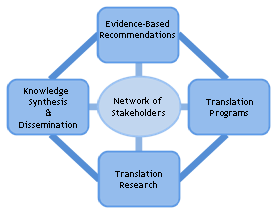Major GAPPNet™ Functions
This website is archived for historical purposes and is no longer being maintained or updated.
GAPPNet™ stakeholders help to identify resources through public and private partnerships to support the major GAPPNet™ functions:
Interrelationship of the
Major GAPPNet™ Functions

- Knowledge Synthesis
- Evidence-Based Recommendation Development
- Translation Research, and
- Translation Programs.
Knowledge Synthesis
A major function of GAPPNet™ is to systematically synthesize information on the validity, utility, and impact of promising genomic applications (e.g., genetic tests, technologies, and family history) and to disseminate this information to researchers, policy makers, health care providers, and consumers. This process also involves the identification of information gaps, where more research will be needed. Read about the ACCE Model Project and EGAPP™ methods [PDF 645.33 KB], and the USPSTF methods for synthesizing knowledge.
Evidence-Based Recommendations Development
Researchers involved in GAPPNet™ use synthesized information on the validity, utility and impact of specific genomic applications to establish evidence-based recommendations. These recommendations, based on the EGAPP™ initiative and other evidence-based processes, are intended to help healthcare providers, policy makers, health plans, and consumers make more informed decisions about the use of these genomic applications.
Learn more about current evidence-based reviews and recommendations on genomics:
- Evaluation of Genomic Applications in Practice and Prevention (EGAPP™)
- U.S. Preventive Services Task Force (USPSTF)
Translation Research
GAPPNet™ promotes multidisciplinary research to help close the information gaps about genomic applications in clinical and public health practice. Translation research involves four phases that revolve around evidence-based recommendations. Phase 1 seeks to use knowledge gained from genetic and genomic discoveries to develop a health application (e.g., genetic test). Phase 2 assesses the value of these applications for health practice leading toward the development of evidence-based recommendations. Phase 3 attempts to move evidence-based recommendations into health practice, through delivery, dissemination, and diffusion research. Finally, phase 4 seeks to evaluate the “real world” health outcomes of the health applications in practice. Read genomics translation article.[PDF 149KB]
The National Cancer Institute at the National Institutes of Health (NIH) is currently funding a number of investigators to conduct translation research and comparative effectiveness research genomics and personalized medicine, and NIH’s National Heart, Lung and Blood Institute is conducting translation research on Warfarin. The Agency for Healthcare Research and Quality is also funding genomics-related projects, as is CDC’s Office of Public Health Genomics.
Translation Programs
GAPPNet™ promotes the translation of promising human genome-based knowledge and applications into public health and clinical practice programs for preventing disease and the improving the health of individuals and populations. OPHG is funding five projects in state health departments and academic and research institutions to translate human-genome information (e.g., genetic risk factors), genetic testing guidelines and recommendations (e.g., EGAPP™, USPSTF), and applications (e.g., family health history risk assessments) into education, surveillance, and policy interventions for chronic diseases. Learn more about these projects.
- Page last reviewed: November 22, 2010 (archived document)
- Content source:


 ShareCompartir
ShareCompartir